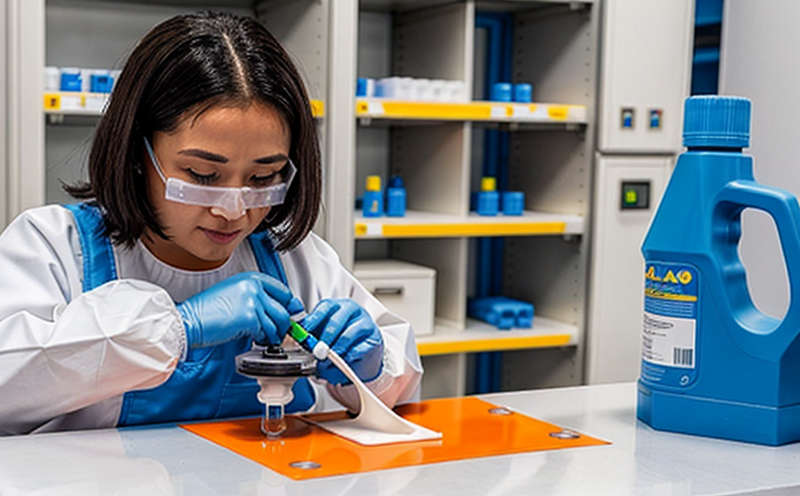ISO 8510 Peel Strength Testing of Nano Reinforced Adhesives
The ISO 8510 peel strength test is a critical procedure used to evaluate the adhesion quality and durability of nano-reinforced adhesives. This test assesses how well an adhesive bonds two substrates, with particular focus on its resistance to separation under dynamic loading conditions. In the context of nano-additives in adhesives and sealants, this test is especially important because it helps determine the effectiveness of nanomaterials in enhancing the mechanical properties of adhesives.
The process involves applying a uniform load across the bonded area until failure occurs. The specimen used for the peel strength test typically consists of two substrates bonded with an adhesive containing nano-reinforcements like carbon nanotubes, graphene, or metal nanoparticles. This setup allows for the precise measurement of the peel force required to separate the bonded layers.
The significance of this testing lies in its ability to provide a quantitative measure of how well the nano-additives are dispersed within the adhesive matrix and their overall impact on the mechanical properties of the final product. The results can inform quality control, optimize formulations, and ensure regulatory compliance with industry standards like ISO 8510.
The peel strength test is particularly relevant in sectors such as automotive manufacturing, construction, and aerospace, where adhesives play a crucial role in structural integrity. In these industries, the reliability of adhesives can significantly influence product performance and safety. By using nano-reinforcements, manufacturers aim to achieve superior tensile strength, elongation at break, and fatigue life.
Real-world applications include the repair of composite structures, bonding critical components, and ensuring long-term durability in harsh environments. For instance, in aerospace, where adhesives are used for joining complex assemblies, peel strength testing is essential to ensure that bonds remain intact under cyclic loading or exposure to high temperatures.
The test setup typically involves a three-point bend fixture with a controlled environmental chamber to simulate real-world conditions during the peel test. The nano-reinforced adhesive specimen is bonded between two rigid substrates and subjected to a peel force applied at a specific angle, usually 180 degrees for complete separation.
Why It Matters
The importance of ISO 8510 peel strength testing cannot be overstated. For quality managers and compliance officers, the results of this test provide a clear indication of whether an adhesive meets specified performance standards. In R&D environments, it serves as a critical tool for optimizing formulations by identifying the optimal concentration and type of nano-additives.
- Ensures product reliability across various environmental conditions
- Enhances safety in high-stress applications
- Optimizes material use through precise formulation
The test is also crucial for procurement teams, as it helps them select suppliers who meet stringent quality benchmarks. In industries where adhesives are a key component of product integrity, such as automotive and aerospace, the peel strength test is indispensable.
Scope and Methodology
| Parameter | Description |
|---|---|
| Type of Specimen | Bonded specimens consisting of two rigid substrates with a nano-reinforced adhesive layer. |
| Peel Angle | 180 degrees for complete separation, ensuring accurate measurement of peel force. |
| Load Rate | Uniformly applied at 5 mm/min to simulate real-world loading conditions. |
| Environmental Conditions | Controlled temperature and humidity to replicate intended use environments. |
The peel strength test adheres to the strict guidelines outlined in ISO 8510, which specifies detailed procedures for testing adhesives. The methodology ensures that all tests are conducted under standardized conditions, providing reliable and comparable data across different materials and manufacturers.
Specimen preparation is critical; it involves cleaning and conditioning both substrates before bonding with the nano-reinforced adhesive. After bonding, the specimens must be allowed to cure according to the manufacturer's recommendations. The curing process ensures that the bond between the substrate and the adhesive is stable and free from any curing defects.
Benefits
- Enhanced Adhesion Performance: Ensures superior adhesion strength, which is crucial for durability in various applications.
- Regulatory Compliance: Meets the stringent requirements of international standards such as ISO 8510.
- R&D Optimization: Provides insights into the effectiveness of nano-reinforcements and helps in formulation optimization.
- Cost Efficiency: Identifies potential issues early, reducing rework and material waste.
The peel strength test not only enhances product performance but also contributes to a more sustainable manufacturing process by ensuring that materials are used efficiently. It is an indispensable tool for manufacturers looking to innovate while maintaining the highest quality standards.





